-
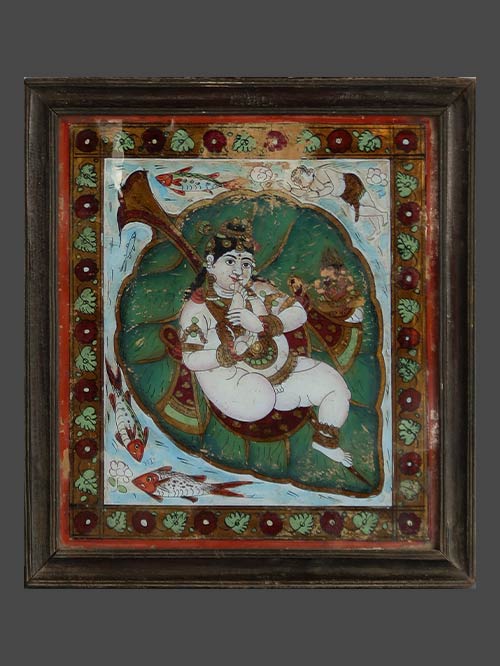
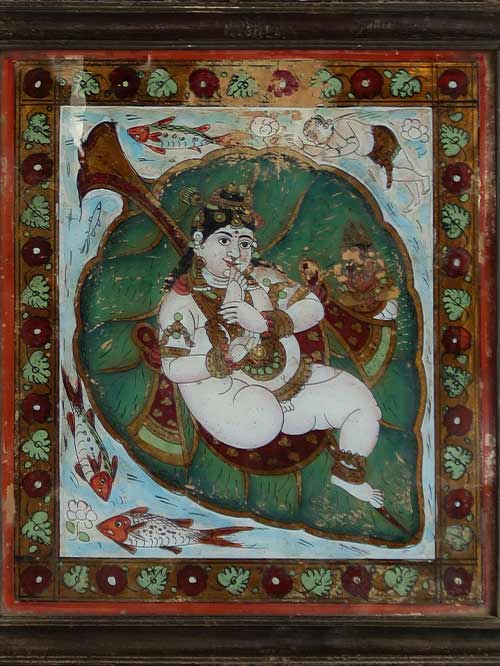
Tanjore (South India)
reverse painting on glass
Krishna as a child lies on a giant banyan leaf content, innocent, with a hint of amusement on his face. Naked but for his jewellery and a draped angavastra, he is depicted sucking his raised toe. As always, he is shown as a chubby child. The leaf he rests on is encircled by a school of fish, swimming amidst the primordial waters. Depicted on the top right is the sage Markandeya reaching out for the safety of the banyan leaf. A diminutive Brahma hovers above Krishna’s left foot. A border of leaves and roundels frames the scene.
The story of Krishna as Vatapatrasayi, or the Lord of the Banyan Leaf, occurs during the end of the world when the sage Markandeya sees the destruction caused by the great flood. In the midst of the chaos, he sees a small child floating on a banyan leaf, sucking his raised toe. Markandeya is drawn into the child’s body where he discovers the entire world, with all its realms, contained within the child who is oblivious to the disaster happening outside. The sage then realises that the child is a god who has taken the world into himself before recreating the universe.
Reverse glass paintings were introduced into India the late 18th century from China by way of the China Trade. Indian artists adopted the technique of reverse glass painting partly on account of its novelty and also because it was a relatively inexpensive medium which could produce rich effects. The technique proved extremely popular and soon spread through western and southern India and even to former provincial Mughal capitals of Oudh, Murshidabad. In Tanjore a distinctive school of glass painting developed, with a rich colour and bold and defiant style. The subjects were clearly presented with a certain opulence and glamour.
Framed Size (cms): 46.5(H) x 41.5(W)
Framed Size (inches): 18.5(H) x 16.5(W)
Painting Size (cms):39.5(H) x 31.5(W)
Painting Size (inches):15.5(H) x 12.5(W)
-

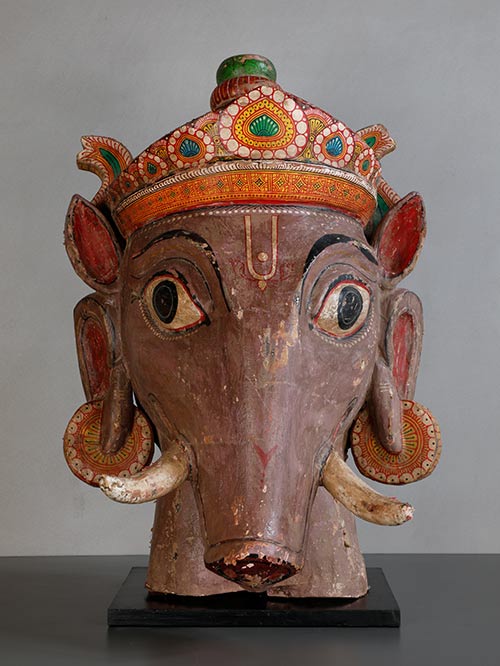
Orissa (Eastern India)
Wood, extensively polychromed
A magnificent and rare processional head in good condition with original colour and patina. Varaha is the third avatar of Lord Vishnu. He is usually depicted as half-human and half-boar, slaying the asura Hiranyaksha and carrying a conch shell, a discus, a mace, and a lotus flower in his four hands. He is considered to be the saviour of the world and the protector of the earth and his worship is believed to bring prosperity and good fortune.
Shahi Jatras (royal processions) of Orissa present different episodes from the Ramayana during the spring season, usually lasting for for one week. Actors, carrying huge wooden masks and gorgeous costumes, walk on the streets with stylized gait and mime with the accompaniment of loud drumming. The Desia Nata of Koraput, Orissa, also uses masks for representing gods, goddesses, animals, birds and demons. These themes are also taken from Ramayana.
Size (cms): 75.5(H) x 59(W) x 56(D)
Size (inches): 29.5(H) x 23(W) x 22(D)
-
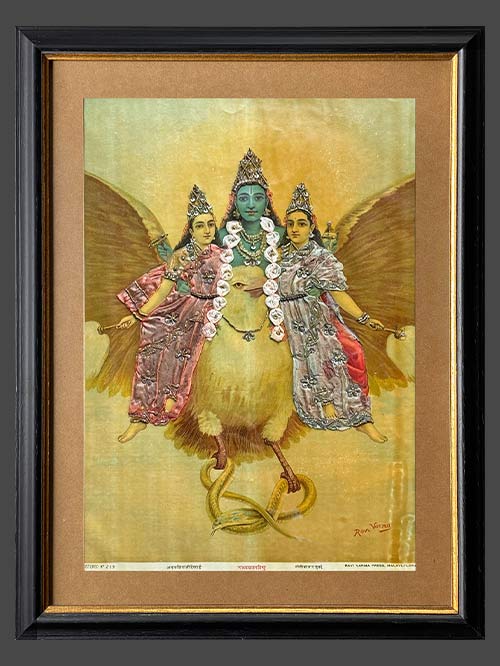
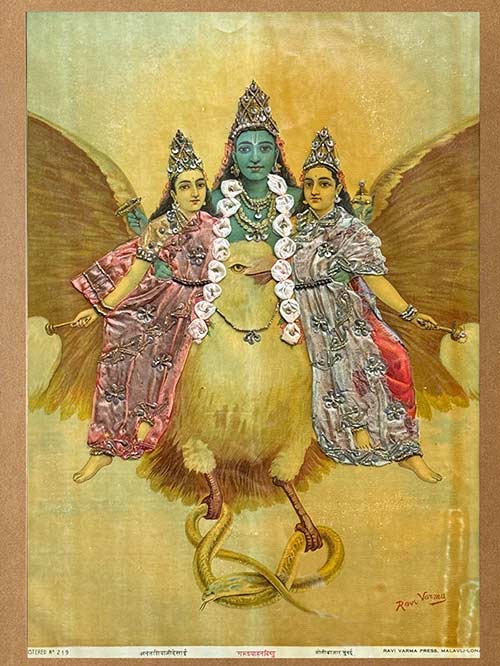
Published at the Ravi Varma Press, Malavli, Lonavla
by Raja Ravi Varma
chromolithograph
Vishnu is is seen here riding on his vahana (vehicle), the mythical bird Garuda with his consorts Sridevi and Bhudevi on either side. The blue skinned Vishnu carries two of his usual attributes, the disc (cakra) and conch (sankha) in his hands. His consorts both bejewelled wear saris and hold chauris (fly whisks) in their outstretched arms. Garuda is depicted mid-flight carrying the trio and holding a golden cobra firmly within its talons.
Ravi Varma occupies an important place in Indian art history. He developed a painting style that appropriated the illusionary techniques of European oil painting with traditional Indian subject matter. The popularity of Ravi Varma’s paintings gave him the idea to make oleographs that would be available to the general public, instead of only elite patrons. Oleographs, also called chromolithographs, are multi-colour art prints, stemming from the process of lithography.
These immensely popular chromolithographs from the Ravi Varma press quickly set a new iconographical standard for the traditional Indian heroes and deities. Often the figures were embellished with embroidered sequins and other decorative material, creating vibrant pulsating images.
Image Size (cms): 49.5 (H) x 34.5 (W)
Image Size (inches): 19.5 (H) x 13.6 (W)
Framed Size (cms): 62 (H) x 48.5 (W)
Framed Size (inches): 24.5 (H) x 19 (W)







